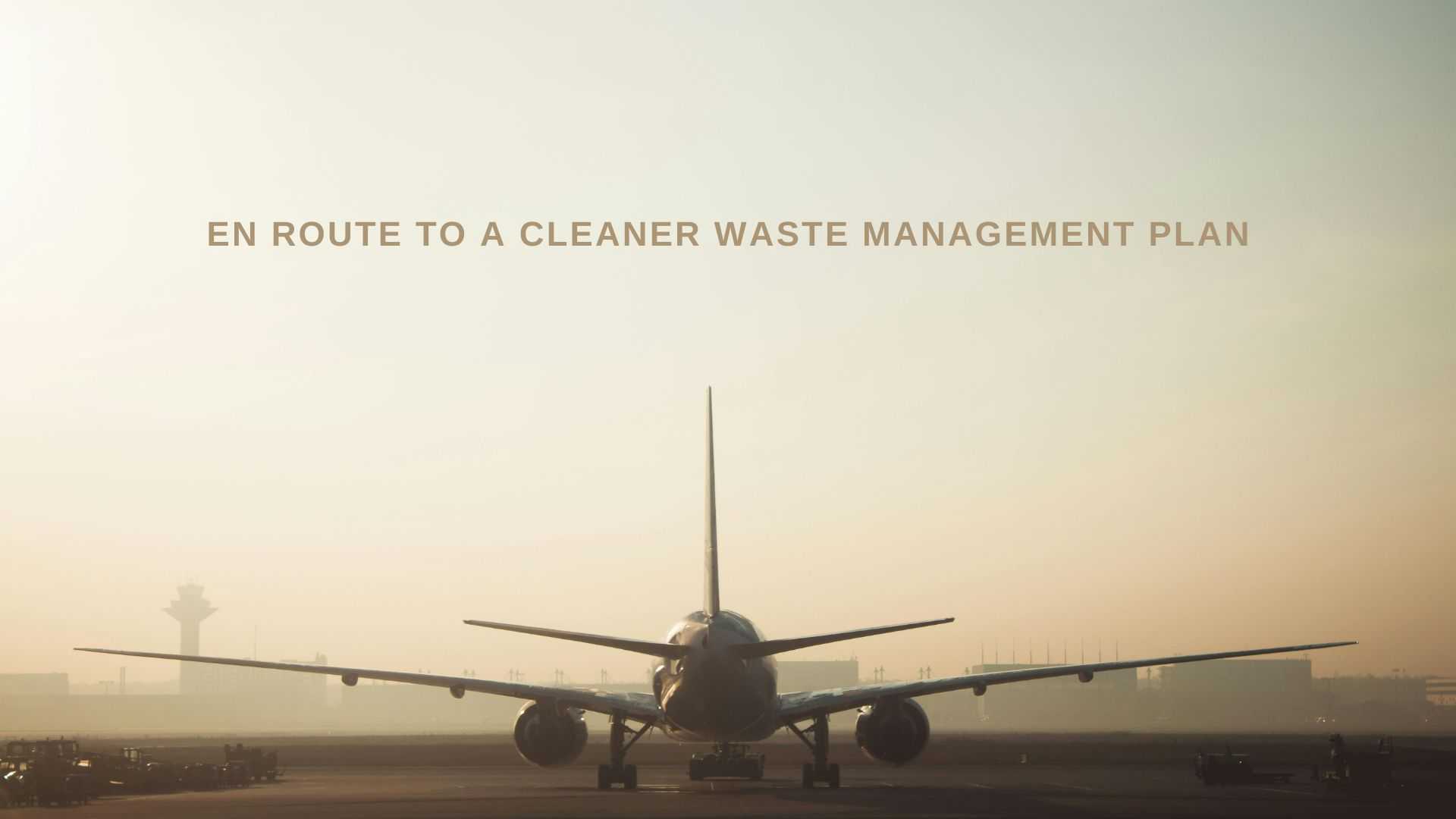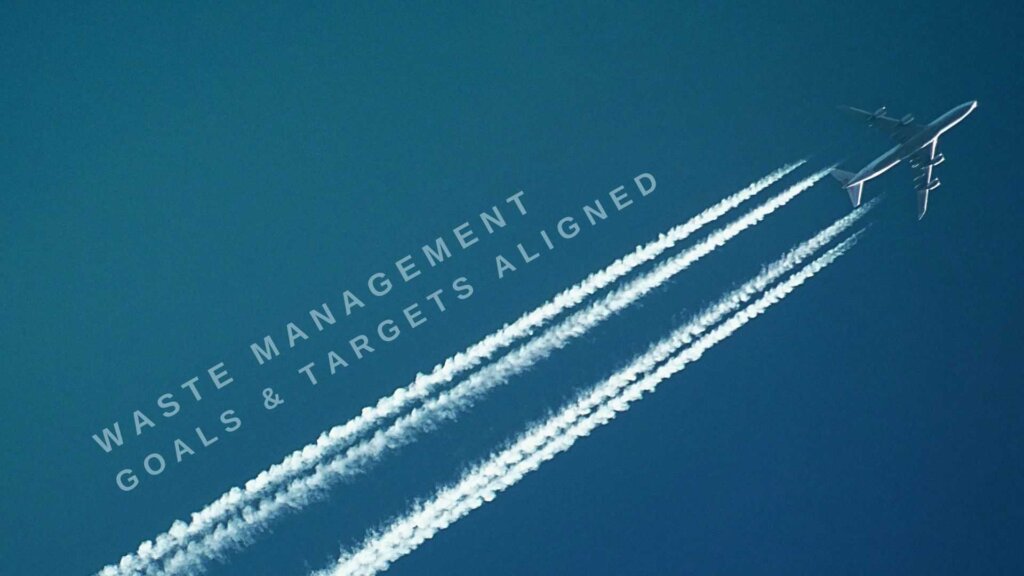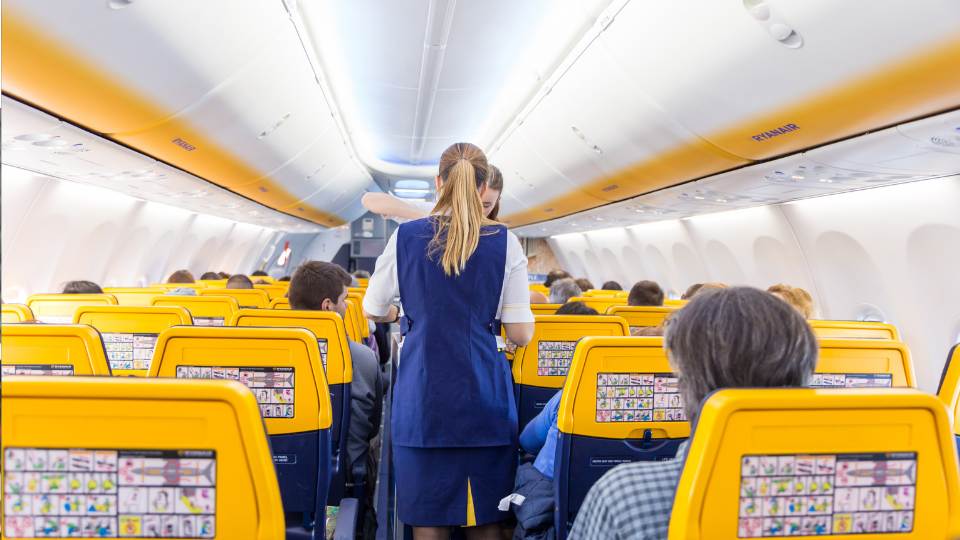
Airports, like any bustling hub, generate a significant amount of rubbish.
Managing this rubbish effectively presents a complex challenge, requiring a delicate balance between efficiency, environmental responsibility, and adherence to local regulations.
This guide, “Waste Management & Recycling at Airports,” delves into the essential principles and approaches for airports to navigate this challenge.
Table of Contents
- Importance of tailored airport waste management practices
- Each site has its own unique issues to tackle
- Terms used in this guide
- International classifications of waste
- Airport & Aviation Waste Types
- The Principles of Airport Waste Management
- Prioritising Waste Reduction
- The Power of Recycling in Airport Waste Management
- Benefits of Construction and Demolition Recycling at Airports
- Waste-to-Energy
- Landfilling: The Last Resort
- Addressing Your Airport’s Waste Management Goals & Targets
- Implementing a Waste Management Program at Airports
- Conclusion
Importance of tailored airport waste management practices

The core of the issue lies in finding sustainable practices that are not only cost-effective but also minimise environmental impact.
Fortunately, a wide range of such practices exist, with the potential to benefit not just the airport itself but also its passengers, the surrounding community, and the environment at large.
Each site has its own unique issues to tackle
However, a one-size-fits-all solution doesn’t exist. Waste management at airports is heavily influenced by the specific regulations and realities of the local and national context.
For instance, a municipality with ambitious waste reduction targets can directly impact the airport’s waste management strategy.
Additionally, the way stakeholders interact with the airport operator, through contracts and assigned responsibilities, further complicates the issue.
Moving beyond the immediate challenge, this guide will also introduce the concept of a circular economy as a tool to minimise waste generation at airports.
The circular economy emphasises reusing and recycling materials, creating a closed-loop system that reduces the need for virgin resources and minimises waste disposal.
Terms used in this guide
To establish a common ground for discussion, the guide begins by defining waste in the context of airports.
Here, waste encompasses any unwanted or unused materials, products, or substances generated within the airport itself.
This waste originates from various sources, including aircraft (both domestic and international), on-site businesses, maintenance activities, ground and air vehicle operations, office spaces, and even construction projects.
Each source generates a different type of waste, requiring unique handling and disposal methods.
The publication acknowledges that a universally accepted definition of waste remains elusive.
This is particularly true when considering the diverse practices, regulations, and levels of waste management maturity across the globe.
While the Oxford English Dictionary offers a general definition of waste as “Unwanted or unused material, substances and by-products,” other entities provide more specific definitions.
International classifications of waste

Many countries have regulations governing the handling and disposal of international waste, particularly hazardous waste.
Airport operators must comply with these regulations, which can significantly impact their waste management strategies.
The Basel Convention further specifies rules for hazardous international waste, encompassing materials that are explosive, flammable, toxic, or corrosive.
Understanding these classifications and complying with relevant regulations is crucial for responsible waste management in airports.
Airport & Aviation Waste Types

Airports, by their very nature, generate a significant amount of waste.
This waste comes from a variety of sources and requires careful management to reduce environmental impact.
Here’s a breakdown of the different types of waste encountered in airport operations:
1. Municipal Solid Waste (MSW):
MSW is the everyday waste generated by passengers, airport staff, and businesses operating within the airport.
This includes familiar items like:
- Metal: Aluminum and steel cans
- Glass: Bottles and containers
- Plastic: Bottles, containers, and packaging bags
- Paper Products: Newspapers, magazines, and other paper items
- Cardboard: Packaging materials
MSW originates from four main areas:
- Terminal Waste: Discarded items from public areas and administrative offices within the terminal building.
- Tenant Waste: Waste generated by shops, restaurants, and other concession stands in the terminal.
- Airline Waste: Trash collected from aeroplanes and airline offices.
- Cargo Waste: Discarded materials from cargo handling operations.
Due to its diverse nature, MSW offers airports the most options for management.
Effective strategies for the collection, treatment, storage, and disposal of MSW can significantly improve airport operations and reduce environmental impact.
2. Construction and Demolition Debris (CDD)
Airports are constantly evolving, with new construction projects and renovations generating a unique type of waste: CDD.
This debris can come from various activities, including:
- Land clearing and excavation
- Construction of new buildings and infrastructure
- Demolition of older structures
CDD encompasses a wide range of materials, such as:
- Concrete, wood, and metals
- Soil, bricks, and masonry materials
- Asphalt, rock, stone, and gravel
- Sand, roofing materials, drywall, and carpet
- Plastic, pipes, and other assorted materials
Managing CDD effectively requires proper sorting and recycling opportunities whenever possible.
3. Deplaned Waste

Waste from aeroplanes, also known as deplaned waste, is a specific type of MSW with a surprising contribution to the overall airport waste stream.
Studies indicate that deplaned waste can account for nearly 20% of an airport’s total MSW.
This category includes:
- Passenger Waste: Discarded items from passengers during the flight, such as food scraps, beverage containers, and reading materials.
- Galley Waste: Materials collected by airline caterers during the de-catering process.
This includes waste from food preparation and service, like compactor boxes, waste carts, and food carts.
Due to potential biosecurity concerns, galley waste may require stricter disposal methods compared to regular passenger waste.
4. International Waste
International flights present a unique waste management challenge.
Waste originating from these flights, as well as waste from terminals servicing them, requires special attention due to potential differences in regulations and policies between countries.
Strict guidelines are often necessary to prevent the introduction of invasive species or diseases through discarded items.
This may involve additional sorting procedures and specialised disposal methods for international waste.
By understanding the diverse types of waste generated at airports and implementing effective management strategies, airport authorities can contribute to a more sustainable and environmentally friendly air travel industry.
5. Organic Waste or Composting
Airports produce a considerable amount of organic waste, which can be further divided into two subcategories:
- Food Waste: This includes uneaten food from restaurants and cafes, along with scraps generated during food preparation in kitchens throughout the terminal.
- Green Waste: Landscaping activities at airports contribute to green waste, such as trimmings from trees, shrubs, and grass clippings, along with fallen leaves and other vegetation.
The good news is that both these types of organic waste are biodegradable, meaning they can be broken down naturally by microorganisms.
Traditionally, composting has been a popular method for processing organic waste at airports. Composting facilities convert food scraps and green waste into nutrient-rich soil amendment, which can then be used for landscaping projects or even sold commercially.
However, airports are increasingly exploring innovative solutions for managing organic waste.
These may include:
- Anaerobic Digestion: This process breaks down organic matter in an oxygen-free environment, producing biogas that can be used as a renewable energy source.
- Food Waste Dehydrators: These dehydrators significantly reduce the volume of food waste, making it easier to transport and manage.
While these organic wastes can be classified as Municipal Solid Waste (MSW), their biodegradable nature allows for alternative treatment options compared to traditional MSW disposal methods.
6. Hazardous and Industrial Waste
This category encompasses a wide range of waste products generated during various airport operations, including:
- Oils and solvents used for aircraft and ground vehicle washing, cleaning, and maintenance.
- Waste generated during aircraft fueling operations.
- Materials resulting from aircraft maintenance and repair activities, such as paint, metalwork debris, and de-icing fluids.
- Waste produced from engine test cell operations.
- Discarded materials from ground vehicle maintenance.
- Waste from abandoned aircraft.
Due to the potential environmental and health hazards associated with these materials, hazardous and industrial waste is subject to strict regulations.
Specific treatment, storage, and disposal protocols are mandated by law, and these requirements vary depending on the specific type of waste.
The complex nature of managing hazardous and industrial waste falls outside the scope of this document.
However, it’s important to acknowledge the vital role these regulations play in ensuring the safe handling and disposal of potentially harmful materials.
7. Lavatory Waste
Lavatory waste, containing a combination of chemicals and potentially harmful pathogens, presents a unique challenge for airport waste management.
Improper handling of this type of waste can pose serious risks to both human health and the environment.
Airports must take careful measures to prevent accidental releases of lavatory waste.
This includes using appropriate collection systems, ensuring proper storage and transportation, and following established treatment and disposal protocols.
The Principles of Airport Waste Management
Airports face a unique challenge when it comes to waste generation.
The constant flow of passengers, airlines, and concessionaires creates a diverse waste stream that requires careful management.
To reduce environmental impact and optimise costs, airports are increasingly adopting a waste management hierarchy that prioritises reducing waste in the first place.
Prioritising Waste Reduction
The most effective way to deal with airport waste is to avoid generating it altogether. This can be achieved through various strategies such as:
- Using refillable water bottles and promoting reusable shopping bags:
This tackles the issue of single-use plastic bottles and bags, a major contributor to airport waste.
Airports can partner with concessionaires to offer discounts or incentives for passengers who bring their own reusable water bottles and shopping bags.
Additionally, installing convenient water refill stations throughout the terminal can discourage the purchase of bottled water.
- Encouraging concessionaires to use sustainable packaging:
Airports can incentivise businesses to use biodegradable or compostable packaging materials for food and beverages.
Collaborating with concessionaires to explore alternative packaging options, such as paper or plant-based materials, can significantly reduce reliance on traditional plastic packaging.
- Implementing digital solutions:
Replacing paper boarding passes and printed schedules with digital alternatives can significantly reduce paper waste.
Airports can invest in mobile applications that allow passengers to access boarding passes, flight information, and terminal maps electronically.
This not only reduces paper consumption but also enhances the passenger experience with a more streamlined and convenient travel process.
- Partnering with airlines to reduce single-use items:
Collaboration between airports and airlines can lead to initiatives like eliminating unnecessary in-flight plastic serviceware or offering pre-packaged meals with minimal plastic wrapping.
Airports can leverage their partnerships with airlines to implement sustainable practices throughout the entire travel journey, reducing waste generation at both the airport and onboard flights.
The Power of Recycling in Airport Waste Management
Recycling plays a vital role in diverting waste from landfills and conserving resources.
Airports can establish successful recycling programs by:
- Setting up clearly labelled bins:
Bins for different recyclable materials like paper, plastic, and metal should be easily identifiable and conveniently located throughout the terminal buildings, concourses, and even in public areas outside the terminal.
Using standardised colour-coding systems and clear signage with pictograms can ensure intuitive waste segregation by passengers and staff, regardless of language barriers.
- Educating passengers and staff:
Clear signage, informational kiosks, and awareness campaigns can encourage proper sorting of recyclable items, reducing contamination and improving recycling efficiency.
Engaging educational programs can target both passengers and airport personnel to ensure everyone understands the importance of waste segregation and contributes effectively.
Making use of digital displays and interactive kiosks can provide informative and engaging content to educate travellers about the airport’s recycling practices and encourage their participation.
- Partnering with recycling facilities:
Establishing strong relationships with local recycling facilities ensures proper processing and responsible management of collected recyclables.
Airports can look for partners who specialise in handling the specific types of recyclables generated at airports, such as aluminium cans from beverages or cardboard from packaging materials. Partnering with local facilities not only supports the regional recycling infrastructure but also reduces transportation distances associated with waste hauling, reducing the environmental impact of the recycling process itself.
Benefits of Construction and Demolition Recycling at Airports
Construction, renovation, and maintenance activities at airports generate a significant amount of waste.
However, this waste stream presents an opportunity for resource recovery through:
- Reusing materials on-site:
Whenever possible, airports can strive to reuse concrete, asphalt, and other construction materials within the same project.
This can involve careful planning during demolition phases to segregate reusable materials and store them for later incorporation into the new construction.
Employing deconstruction techniques that meticulously dismantle structures can preserve valuable materials in a way that traditional demolition methods cannot.
- Finding local reuse opportunities:
Excess materials can be diverted from landfills by partnering with local contractors or businesses who can use them in their projects.
Airports can establish online portals or bulletin boards to advertise reusable construction materials, creating a platform for mutually beneficial partnerships within the community.
Partnering with architectural salvage companies or organisations focused on sustainable construction can expand the reach of these reuse initiatives and ensure that valuable materials find new life in other building projects.
- Economic and environmental advantages:
Construction and demolition (C&D) recycling reduces reliance on virgin materials, lowers hauling costs associated with transporting waste to landfills, and reduces the environmental burden of landfilling.
By giving new life to old materials, airports can promote a more circular economy within the construction sector.
C&D recycling not only conserves natural resources but also fosters innovation in the reuse and repurposing of construction materials.
Waste-to-Energy
A portion of airport waste will always be unsuitable for recycling.
Waste-to-energy (WtE) technologies offer a solution by converting this non-recyclable waste into a usable form of energy, such as electricity or heat.
Common WtE technologies employed at airports include:
- Incineration:
This process involves burning waste at high temperatures in a controlled environment. The heat generated during incineration can be used to produce steam that drives turbines for electricity generation or can be captured for district heating purposes.
Modern WtE incineration facilities incorporate advanced pollution control systems to minimise emissions and ensure compliance with environmental regulations.
Did you know that the government is adding extra legislation in the attempt to reduce waste incineration plants? Read more in our dedicated blog!
- Anaerobic digestion:
This biological process breaks down organic waste materials like food scraps and leftover catering supplies in an oxygen-deprived environment.
The process produces biogas, a renewable fuel source that can be used to generate electricity or directly power airport vehicles.
Anaerobic digestion offers a sustainable way to manage organic waste while producing a valuable source of clean energy.
- Gasification:
This thermochemical process converts waste materials into a synthetic gas (syngas) through controlled heating in the absence of oxygen.
The syngas can then be used to generate electricity, produce fuels like hydrogen, or be utilised for industrial processes.
Gasification offers a versatile approach to waste-to-energy conversion, potentially creating a valuable energy source from a diverse range of non-recyclable waste streams.
Important considerations for WtE technologies:
- Environmental impact:
While WtE facilities have significantly improved their environmental performance, concerns remain regarding air emissions and ash residue.
Airports considering WtE technologies should conduct thorough environmental impact assessments and ensure facilities meet stringent emission control standards.
- Public perception:
WtE facilities can sometimes face public opposition due to concerns about potential health risks.
Airports implementing WtE solutions should prioritise transparent communication with the community, addressing concerns and emphasising the environmental benefits of diverting waste from landfills and generating renewable energy.
Landfilling: The Last Resort

Despite the advancements in waste reduction, recycling, and WtE technologies, some airport waste will ultimately require disposal in landfills.
However, airports can still reduce their reliance on landfills by:
- Maximising recycling and WtE diversion:
The more waste diverted from landfills through recycling and energy conversion, the less reliant airports become on landfill disposal.
By continuously optimising waste management practices and exploring innovative solutions, airports can strive to reduce the amount of waste destined for landfills.
- Partnering with sustainable landfills:
Modern landfills increasingly incorporate technologies to capture methane gas emissions, a potent greenhouse gas, and convert it into usable energy.
Airports can partner with landfills that employ these sustainable practices, ensuring any unavoidable waste disposal contributes minimally to the overall environmental impact.
By adopting a comprehensive waste management hierarchy that prioritises reduction, reuse, recycling, and WtE, airports can significantly reduce their environmental footprint and contribute to a more sustainable future for air travel.
Addressing Your Airport’s Waste Management Goals & Targets
Start with audits, KPI-based waste management plans, implementation goals & evaluation.
Airports, while vital hubs for global connectivity, generate significant amounts of waste.
To minimise this environmental footprint, a comprehensive waste management strategy is essential.
This strategy should not only focus on maximising recycling and reuse, but also consider the social, economic, and operational aspects of waste management within the broader airport ecosystem.
1. Waste Audit
The cornerstone of any effective waste management plan is a thorough waste audit.
This detailed study meticulously characterises the types of waste generated at the airport, pinpointing their origin and final destination.
It quantifies waste volumes, identifies opportunities for enhanced recycling, reuse, and reduction, and serves as a benchmark for measuring future progress.
A well-conducted waste audit provides invaluable insights into passenger and staff behaviour patterns, revealing how everyday items are distributed and used across the airport.
However, to ensure its effectiveness, the audit must consider the unique characteristics of each airport, including its geographical location and social context.
Airport operations and applicable regulations also play a critical role, necessitating specialised knowledge for accurate data collection and analysis.
2. Crafting a Sustainable Waste Management and Reduction Plan
Armed with the insights gleaned from the waste audit (or existing data on waste patterns), a strategic waste management and reduction plan can be formulated to form a sustainable airport.
This plan should be firmly anchored in a clear policy established by airport management, ensuring alignment with national and regional regulatory frameworks.
The specific content and scope of the plan will naturally vary depending on the size and location of the airport.
However, some core elements should remain consistent.
These include:
- Clearly defined goals and objectives for waste management.
- A comprehensive list of stakeholders involved in the waste management process.
- A detailed characterisation of the waste generated at the airport.
- A robust strategy for waste reduction across various airport operations.
- A thorough description of the airport’s current waste handling processes, including separation, collection, and transportation.
The implementation process for the waste management plan should be meticulously documented and integrated within the airport’s standard operating procedures.
While the level of detail may vary based on airport size, the core principles of separation, collection, and transportation should remain consistent.
This plan can be incorporated into the airport’s master development plan or its sustainability strategy.
Additionally, strategies to foster engagement with employees, managers, and concessionaires can be included to ensure a collaborative approach.
3. Successful Implementation Strategy
The successful execution of a waste management plan hinges on a multitude of factors.
Crucially, it should be embedded within the airport’s overall corporate strategy, fostering collaboration with all stakeholders who play a role in waste management within their areas of responsibility.
The policy should be subject to periodic reviews, with protocols adapted to reflect evolving circumstances.
Leveraging incentives
Identifying economic incentives for waste reduction, reuse, and recycling is paramount.
These economic instruments can guide the implementation of a cost-effective waste management approach tailored to the specific airport’s local and regional context.
For instance, in some regions, direct airport involvement in all aspects of waste separation, collection, and transportation may prove more cost-effective.
Alternatively, subcontracting these services might be a more suitable solution in other regions.
Staff, concessionaires, and passengers must all be included in the waste management equation through targeted education campaigns.
Clear communication
An effective communication strategy should be developed to reach both internal and external stakeholders.
The airport website can be a valuable tool for disseminating information, but exploring additional means to connect with local communities is also crucial.
Airports that share ownership of premises or employ staff from other organisations need to establish robust consultation mechanisms to address shared waste management challenges.
Publicising the benefits of implementing waste management procedures can serve as a powerful motivator, encouraging employees to adopt sustainable practices in their daily work.
Monitoring and Evaluation
A comprehensive monitoring and evaluation system is essential for airport operators to accurately assess progress towards achieving the targets established in their waste management strategy.
While the specific procedures may differ in terms of detail, the underlying principles should remain consistent and compliant with other airport management requirements.
Analysing existing monitoring practices within other airport operational areas can provide valuable insights into potentially suitable approaches for waste management monitoring and evaluation.
The foundation of a robust monitoring system could encompass, but is not limited to:
- Consistent measurement and reporting of waste data.
- Collection of data required to assess progress towards achieving established targets.
Evaluation should be grounded in readily identifiable Key Performance Indicators (KPIs) that can be readily amended if needed to maintain accuracy.
KPIs should enable year-on-year progress benchmarking and facilitate comparisons with similar airports. Common metrics used for waste management include the weight and rate of different waste types generated and diverted from landfill (e.g., kg/tons of recycling; percentage of waste diversion).
Metrics should be designed to accurately estimate the quantity and composition of waste produced.
Implementing a Waste Management Program at Airports
This section outlines a guide for establishing a waste management program at airports, incorporating the principles of a circular economy.
1. Stakeholder Engagement and Education (Communication)
Successful waste reduction efforts require effective communication and outreach among all airport stakeholders.
Here’s how to achieve this:
Publish results:
Share highlights, data, and success metrics regarding the airport’s waste reduction efforts.
This transparency motivates stakeholders, demonstrates the airport’s commitment to sustainability, and fosters positive media coverage.
Identify Stakeholders:
- Passengers using public areas, parking lots, garages, curbside pickup/drop-off zones, restrooms, holding areas, and food courts.
- Tenants like businesses, airlines, and concessions (including taxis, hotels, rental cars, flight kitchens, and other industries operating at the airport).
- Airline employees (ground crew, cabin cleaning crew, catering).
- Airport authority employees, government offices, business agencies, etc.
- Maintenance operations and support facilities.
- Contractors (aircraft cleaning and service, janitorial services, waste hauliers, and construction contractors) for the airport and its tenants.
- City or County solid waste management.
2. Waste Surveys, Audits, Statistics with Proper Metrics
Before developing a recycling plan, understanding the airport’s waste generation is crucial.
A waste assessment provides both qualitative and quantitative data, establishing a baseline for future progress.
Here’s what a waste assessment can help you determine:
- Waste generation areas: Which areas of the airport generate the most waste?
- Recyclable materials: What recyclable materials are present in the waste stream?
- Waste types by area: What kind of waste is generated in each area of the airport?
- Waste quantities by area: How much waste is generated by each area (airlines, airport offices, passengers, concessions, etc.)?
- Waste management expenses: Costs associated with trash and recycling containers, hauling, disposal/recycling, and labour.
There are three primary approaches to conducting a waste assessment:
Records Examination
This method offers information on waste quantity, labour costs, equipment, and services.
If a centralised waste management system isn’t in place, gather waste data from different hauliers servicing the airport.
Useful records include purchasing, inventory, maintenance, and operating logs; supply and equipment invoices; and waste hauling and disposal records with contracts.
Facility Walk-Through
This provides qualitative waste information through observing staff and passengers.
The primary benefit is firsthand observation of waste handling practices.
Observe the types and amounts of waste generated in each area, track waste movement through the airport, and assess existing space and equipment for waste storage, recyclable processing, and collection tasks.
Talk to staff about their waste generation and disposal habits. Custodial staff are a valuable source of information during a walk-through.
Waste Audit (Waste Sort)
This is the most comprehensive and resource-intensive assessment.
It involves examining the contents of waste receptacles throughout the airport to evaluate what materials are discarded and from where.
A waste audit should include:
- Identifying materials that can and cannot be recycled in the region.
- Locations within the airport that generate waste.
- The types of waste generated in each area (paper, scrap metal, plastic, etc.).
- Identifying materials that can be reduced, reused, and recycled.
- The quantity of waste generated by each area of the airport (airlines, administrative offices, enplaned and deplaned passengers, concessions, etc.).
- Commodity rates for recyclable materials.
- Costs associated with processing recyclables.
- Hauling, disposal, and labour costs for landfill-bound waste.
3. Waste Infrastructure with Signage (Colours, Icons, Terms)
Consistent waste signage using colours, icons, and clear terms helps users quickly identify and sort recyclables, reducing contamination and increasing recycling rates.
The signage should be easily understandable by airport passengers, staff, and other stakeholders.
Here are some challenges to consider:
- International passengers: Different colours, icons, and terms used by various airports due to local regulations and cultures can be confusing for international passengers (and potentially domestic passengers as well).
- Finding a universal standard: The lack of international waste signage standards is a challenge for airports receiving international passengers.
- Iconography vs. language: Icons can be a user-friendly alternative, regardless of passenger language, if they effectively communicate sorting instructions.
Here are some tips for effective signage:
- Passenger behaviour assessment: Consider passenger behaviour to identify cultural habits that improved signage can address.
- Bin compatibility: Ensure commonly purchased items at the airport fit into the designated waste bins.
- Consistency across the airport: Maintain consistent signage and education for all stakeholders and across all facilities and collection points.
Conclusion
Implementing a comprehensive waste management program at airports requires a multi-faceted approach.
Stakeholder engagement, thorough waste assessments, and clear communication are essential for success.
By embracing the principles of a circular economy, airports can prioritise waste reduction, reuse, and recycling, reducing their environmental impact and fostering a more sustainable future for air travel.







